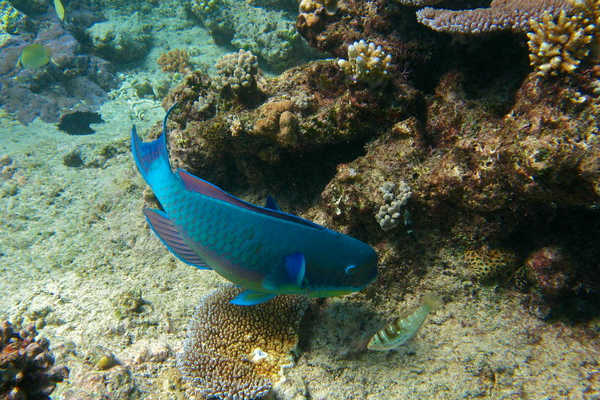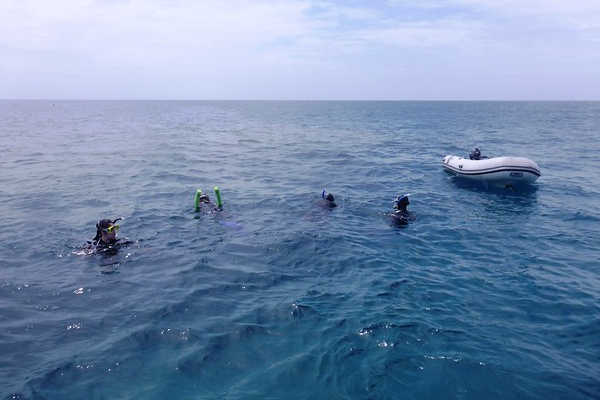Saxon Reef, Great Barrier Reef
Cairns, Queensland 4805
The Great Barrier Reef is made up of thousands of individual reefs, each of which offer their own collections of corals, underwater marine life, and diving opportunities.
Where is the Saxon Reef?
Saxon Reef can be found between Norman Reef and Hasting Reefs and is home to some of the most vibrant species in the vicinity. It covers about 1.9 square kilometres and is one of the quieter diving spots in the region, giving you the chance to explore the underwater world without the crowds. It is ideal for scuba divers and snorkellers who really want to get up close and personal with everything the Great Barrier Reef has to offer. The temperatures are typically always warm throughout the year, with the best sea conditions between June as well as September to November. The rainiest season is between November and March, which may lead to choppy currents and harder visibility, but it is still a spectacular sight to see regardless.
What can you see along this reef?
-
Shallow Sections of Coral
What’s great about Saxon reef is that you don’t have to be a big swimmer to explore it. With many of the sections shallow enough to allow visitors to stand without trouble. Allowing visitors, a break from swimming when they spend an extended time along the reef. This can be perfect for those inexperienced snorkelers and others with a lower level of fitness, including even children. The shallow spots are not without wildlife however, as the coral spots are littered exotic Spanish dancer flatworms and the iconic clownfish anemones clinging to the rocky coral.
-
Larger Marine Life
Those who want to go a little deeper can enjoy a scuba diving adventure. Diving to the deeper sections where visitors can be greeted by moray eels, painted crayfish, and large glass-eyed cod. These sections are the sandy sea floors between the large coral formations, with divers getting to swim down to the very bottom where the marine life roams. There are even chances of seeing stingrays and sharks in these sections, lying in wait to grab some nearby prey. However, guests shouldn’t worry, as these predators are smaller white-tip reef sharks that are no harm to humans. These creatures are like miniature great white sharks, but with brownish-grey coloured with a short blunt snout.
Large fish swarm the reef, including popular diagonally banded sweetlips, parrotfish, and butterflyfish. These fish are easy to spot among the deep blue, with the diagonally banded sweetlips a fluoro yellow, with white and black stripes running along the body. Parrotfish have gotten their name due to their similarity between the flying bird, with the colourful green, blues, and reds, and beck like lips. Finally, the butterflyfish are popular in many of the country’s postcards and advertisements
white-tip reef sharks, diagonally banded sweetlips, barramundi cod, and dozens of species of wrasse, parrotfish and butterflyfish.
-
A Kaleidoscope of Colour
During the sunny days along the Great Barrier Reef, the Saxon Reef comes to life! This is all due to the sunny glow pouring down, filtering through the water, and reflecting along the seabed. The reflected light enhances the coral colours of the Saxon Reef, created a sensational underwater site straight out of a Finding Nemo scene. The warm tropical waters make this swim even better, with visitors spending hours within this underwater paradise without even getting a chill.
-
Breath-Taking Beauty
Regardless of whether you are coming to the Great Barrier Reef for, whether it is snorkelling, scuba diving, swimming, sailing, or more, you can do it at the Saxon Reef. It is one of the top Great Barrier Reef spots for a range of wildlife, with different environments perfect for a wide collection of fishes and mammals.
Snorkelling at Saxon Reef
Snorkelling is one of the most popular activities at Saxon Reef, and its sprawling coral formations make it the ideal spot for both beginners and experienced snorkellers.
The sloping walls of the reef are peppered with all sorts of colourful creatures, including clownfish anemones and Spanish dancer flatworms. Take the time to float below the surface and soak up the stunning underwater views and the eclectic mixture of species.
What’s more, Saxon Reef boasts several shallow platforms which highlight the unusual formations of the coral and make ideal resting spots for damsel fish and fusiliers. You might also be able to catch a glimpse of the mesmerizing marine turtles here, as they elegantly pop up above the surface for a breather.
Scuba Diving at Saxon Reef
Scuba diving is another firm favourite activity at Saxon Reef. Whereas snorkelling sees you observing the surface spots of the reef, scuba diving lets you go a little deeper and explore some of the more hidden parts of the reef.
The reef itself is made up of a collection of coral “bommies”, each of which boast their own special features. Here, you’ll be able to swim amongst moray eels, large cod, barramundi, and painted crayfish.
Further below the surface, giant underwater mountains made up of coral lead down to the sandy bottom of the ocean where sharks and stingrays keep cool during the hot Australian days. Alongside the steep coral wall, you can marvel at the soft coral collection, the unusual lionfish, and, if you’re lucky, a turtle or two.
The Dive Sites at Saxon Reef
Despite it being one of the smaller reefs that make up the Great Barrier Reef, Saxon Reef still offers a selection of prime dive sites. These include Twin Peaks, Mooring, Clipper Mooring, and Turtle Bommie Mooring. Each one provides divers with a unique selection of marine life and coral formations.








